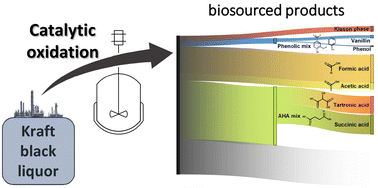Potential of catalytic oxidation of kraft black liquor for the production of biosourced compounds†
Abstract
Industrial kraft black liquor from maritime pine was oxidised in aqueous, alkaline medium, under air, at 150 °C, with or without a CuO/TiO2 catalyst. The oxidation products were analysed by HPLC, elemental analysis, SEC, FTIR, NMR. The results showed the depolymerisation of lignin, the formation of phenolic compounds in low yields, with vanillin being the main phenolic compound, and the formation of aliphatic compounds in higher yields, with formic, succinic and tartronic acids being the main identified aliphatic compounds. The presence of the catalyst favoured the formation of phenolic and aliphatic compounds. Replacing kraft black liquor by pure kraft lignin as a starting material did not improve the performances of the catalytic oxidation, indicating that lignin purification may not be necessary under our conditions. Switching from a batch reactor to a fixed bed reactor, operating under similar conditions, did not increase the yields of oxidation products but did increase the productivity. This work demonstrates the potential of kraft black liquor to produce a large panel of compounds, including phenolics, aliphatic acids and oxidised lignin, all of which are valuable in the chemical industry. For the first time, a catalytic process for the chemical valorisation of kraft black liquor is presented.

- This article is part of the themed collection: International Symposium on Green Chemistry 2022


 Please wait while we load your content...
Please wait while we load your content...